Some examples of the system:
- A completely pollen-free tree like Red Maple 'Autumn Glory,' ranks at 1 (the best).
- Double Hollyhocks are ranked 2, and single Hollyhocks rank at 3. The common shrub Abelia ranks at 5, while Japanese Boxwood is ranked 7. Few realize Boxwood even has flowers, but it does and they do cause allergy unless kept closely clipped.
- At the high allergy end are plants like Bottlebrush, ranked 9, and staminate pepper trees (the ones without the berries) ranking 10, the most allergenic.
The complete OPALSTM scale is in the book, Allergy-Free Gardening, published by Random House Publishers. Over 5,000 plants are individually allergy-ranked.
Interest in the connection between allergy and urban landscapes has increased recently driven by several factors. First, allergy rates are rising at an epidemic pace. This is true in the US and in all urban cities worldwide. Twenty-five years ago only 10% of the US population suffered from allergy. Today the official figure is 38% and rising. Second, deaths from asthma, long ago almost unknown, are now becoming common. 7,000 people are expected to die in the US in the year 2000 "from complications due to asthma." A very high percentage of the asthma victims will be children.
Years ago the author found that simply describing all plants as either high-allergy or low-allergy is a vast over-simplification. There are many fine plants that are capable of causing some allergy, but rarely serious allergy, like asthma. There are other plants that can cause allergy but only from contact with the sap, or from their fragrance.
Certain species of plants were found to cause allergy but only to very few people. After years of research it became more and more evident that what was needed was a numerical scale, one that would give an accurate prediction of each plant's potential to cause allergy.
The scale that emerged was built on a foundation of two fundamental questions. First, "What do plants that are known not to cause allergies have in common with each other?" And Second, "What do plants that are well known to cause allergies have in common?"
Using these two questions, two large sets of allergy criteria factors were established, one set with positive values, and the other with negative values. Eventually the criteria lists included more than 120 individual factors, and these were weighted according to importance. Not all factors apply to each plant evaluated.
In 1999 the OPALSTM scale passed several difficult tests. It was reviewed by a number of allergists and noted botanists. David Stadtner MD, a board certified allergist and immunologist from Stockton, California, wrote about the scale, "This will be an extremely useful tool for stopping pollen-allergy."
Walter H. Lewis PhD, botany and biology professor at Washington University, St Louis, Missouri, and Senior Botanist at the prestigious Missouri Botanical Gardens, reviewed the scale and the book, and wrote, "What a grand contribution to fields of pollen allergy, horticulture, and the garden. Congratulations to you both: Tom for conceiving and writing Allergy-Free Gardening, and Ten Speed Press for picking it up for publication."
Also in 1999 OPALSTM gained even more clout when the USDA Urban Foresters from Syracuse, New York, Northeastern Research Station, led by David Nowak PhD, adopted the scale for use in formatting pollen-allergy projections. The USDA is combining its own very extensive species bio-mass data with the OPALSTM allergy numbers. The results will be released as individual allergy projections for all major US urban areas.
If we look at the makeup of today's typical urban forest, it is quickly apparent that our modern landscapes are heavily stacked with huge numbers of high-allergy trees and shrubs. Allergy-potential has rarely been an issue when choosing street trees because there simply has not been a reliable method available for making this determination. Within the same species of trees, for example, can be found certain cultivars that rank at the very bottom of the scale and others that rank at the top. Until now city arborists had no way to measure the allergy potential of what they planted.
This, of course, has all suddenly changed with the appearance of OPALSTM. An astute landscaper can now look over a customer's yard and with a high degree of reliability, give the entire landscape a numerical ranking. Actually, any landscape that would rank out at 5 or less, would be considered to be a fairly low allergy landscape; but in the near future, many customers may demand gardens that rate even better, 4s, or 3s, or even lower. It is actually possible to create an entire landscape now, from the lawns to the trees, that ranks out at 1. Such a landscape would in effect be completely pollen-free, and would also not pose any risks from contact allergy, or from what allergists often refer to as negative odor challenges.
A number of quite significant changes may be expected soon because of OPALSTM:
- First, as well educated customers become aware of the scale, everyone in the horticulture trade will also be expected to understand it.
- Second, many currently popular plants that are high-allergy rated, will quickly fall "out of fashion," and demand for them will drop dramatically.
- Third, plant material that ranks favorably, plants in the 1 to 3 range in particular, will rapidly gain in popularity, and demand can be expected to initially outstrip supply.
- Fourth, local and state government organizations can be expected in many cases to stipulate that all of their new landscapes conform to the best OPALSTM rankings.
- Fifth, communities that have promoted this kind of landscaping will advertise it, and will attract people who wish to live in areas with low pollen-allergy potential. In some cases this will affect the actual sales value of area real estate. It will be found, as more urban areas are evaluated with these data, that one part of town may have much lower allergy levels than another part of the same town.
- Sixth, in the future it can be expected that many progressive and health-conscious nurseries will start to carry a line of plants in which every plant has the written, certified endorsement of OPALS-based, Allergy-Free Gardening. These collections could be either all pollen-free selections, or a combination of pollen-free and other exceptional low-allergy landscape plants. Savvy customers should start looking for these collections. The preferred name of this line or collection would be The Allergy Free Garden Collection.
|
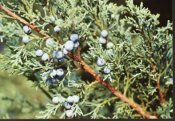
Female Juniper
OPALS™ Rank=1
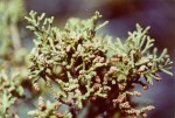
Male Juniper
OPALS™ Rank=10
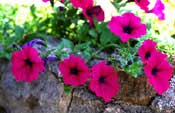
Petunia 'Purple Wave'
OPALS™ Rank=1
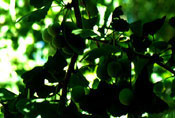 Ginko Biloba Ginko Biloba
A female tree
OPALS™ rank=3 Cedrus deodara
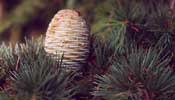
Female
OPALS™ rank=1
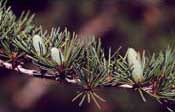
Male
OPALS™ rank=7
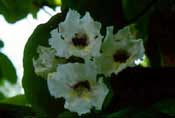
Catalpa speciosa
OPALS™ rank=8
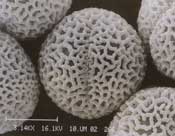
Olive pollen. Highly allergenic
OPALS™ rank=10
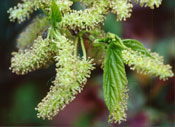
Male Mulberry Tree
OPALS™ rank=10
|










